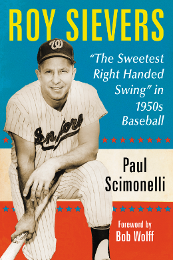Outfielder Roberto Ortiz, who was born in Camaguey, Cuba in 1915, had a respectable, if abbreviated, career in The Show. In parts of six seasons, all of six games of which were played for the then-Washington Senators, from 1941-1944, and then 1949-1950, he appeared in a total of 213 games, came up to the plate 659 times and collected 168 hits, including 18 doubles, 10 triples and eight home runs. He also scored 67 runs and was credited with 78 runs batted in; his lifetime average was .255.
Of the more than 17,000 men who have played the game, Ortiz would be just a blip on the radar if it weren’t for the fact that Major League Baseball, the Major League Baseball Players Association (the union) and the Major League Baseball Players Alumni Association are trying to track down his whereabouts. See, Ortiz is among the 900 or so men who played baseball between 1947 and 1979 and who don’t currently receive pensions from Major League Baseball (MLB). To try to remedy this, MLB and the union jointly announced with much fanfare last April 21st that these men will receive up to $10,000 per year, depending on their length of service credit, as compensation for their contributions to the national pastime.
Regrettably, there’s one slight problem, in Mr. Ortiz’s particular case: he’s been dead since 1971.
Hey Commissioner Bud Selig — you wanna find Ortiz? He’s buried in Flagler Memorial Park in Miami, Florida!
The late Mr. Ortiz is on a list of some 98 men that the league, union and alumni association can’t disburse their charitable payments to. Others on the list include Masanori Murakami, a native of Japan who pitched for the San Francisco Giants in the early 1960s, and Ed Armbrister, who 37 years ago, in the bottom of the 10th inning of Game 3 of the 1975 World Series, laid down a sacrifice bunt and famously interfered with catcher Carlton Fisk, thereby costing the Boston Red Sox the game.
That memorable play occurred on October 14, 1975. By then, Ortiz, who passed away on September 15, 1971, had already been dead four years.
Why are the league, the union and the alumni association trying to pay a dead man? Granted, since Mr. Ortiz was also technically a pre-1947 player (the players pension fund was established in 1947 ) and pre-’47 players such as the late Harry “The Horse” Danning, the All-Star New York Giant catcher who got that nickname because his parents loved the Daymon Runyon character, started receiving quarterly $2,500 payments in October 1997 — another supposed good will gesture by MLB — it’s possible that they’re trying to compensate Ortiz or, strictly speaking, his heirs for the period when he played before 1947. But the problem with that reasoning is, survivor payments aren’t part of the payment plan.
But if they’re attempting to pay Ortiz’s loved ones for his service credit after 1947 that opens up an entirely different can of worms.
What about all those widows and children of the men who died before the big April 21st announcement last year? Individuals like Laurie and Amy King, who lost their beloved father, Nellie, on August 11, 2010. Before his broadcasting career started, Nellie was a pitcher for the Pittsburgh Pirates. Using the logic of paying Ortiz, shouldn’t they be entitled to something too?
Or Gayle Schlueter, whose husband, Jay, passed away three months earlier, on May 11, 2010. A former Houston Astro, Jay battled ataxia, a neurological condition that impairs one’s motor skills, in his post-baseball career. Should Mrs. Schlueter be receiving any compensation?
Maybe this is just a big bureaucratic snafu, and the league, the union and the alumni association made a mistake.
Well, if it is just a mistake, it’s a foolish one. If it’s not, it could prove to be an extremely costly one.






